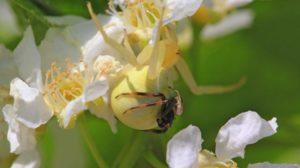Flower spider side walker yellow: cute little hunter
The variety of spiders in nature is amazing. There are large individuals that can frighten with their terrible appearance, and there are small cute individuals that do not scare, but touch. Among the bright ones there are noticeable - small yellow spiders.
Content
Flower spider: photo
Description of the spider
Name: flower spider
Latin: Misumena vatiaClass: Arachnida - Arachnida
Squad: Spiders - Araneae
Family: Sidewalkers - Thomisidae
 | Habitats: | grass and flowers |
 | Dangerous for: | small insects |
 | Attitude towards people: | bites but not venomous |
The yellow spider in Russia is a flower spider. So he was named for the peculiarities of hunting - on the flowers the animal lies in wait for the victim. Its official name is Mizumena clubfoot.
Habitat and distribution
Spiders are very common. They prefer warm temperate and subtropical climates. Their favorite places are open glades with enough sun, meadows and forest edges. They do not like moisture and stagnant moisture. They themselves spread or flower spiders were brought in:
- to North America;
- Ciscaucasia;
- Asia;
- Europe;
- Central Eurasia;
- Mexico.
Hunting and food preferences
The flower spider fully justifies its name. It has an amazing ability to adapt to the characteristics of the environment, thanks to its translucent body. In the diet of the spider are insects that are pollinators of flowers. The hunt goes like this:
- He hides on a flower, so he chooses yellow ones and waits for prey.
- When an insect flies up, the spider concentrates and waits.
- When prey sits in a flower and begins to eat it, the spider quickly attacks.
- The yellow spider grabs the caught victim with its front legs, bites, injecting poison.
- When the living creature dies, the spider injects digestive juices into it, which turns it into a nutrient mixture.
- The spider can eat everything at once or leave it in reserve.
Sometimes a small spider cannot cope with a large prey and becomes prey itself. Most often, flower spiders are destroyed by aggressive wasps.
Reproduction
Flower spiders are loners, their social feelings are not developed. They live alone, if two meet in the same territory, then the smaller individual may die, become food for the larger one.
During breeding, and the mating season falls on spring or early summer, the male begins an active but cautious search for females. When the female lets go, the male quickly fertilizes and leaves, because he can be eaten.
Egg laying occurs in mid-summer in a cocoon that is attached to the sides of the flowers. Until the full development of the offspring and their landing from the eggs, the spider guards them, and then leaves them to their own devices.
Population and natural enemies
There is no evidence that this species is threatened. People don't encounter them anymore because their camouflage works great.
Flower spiders are common, although they suffer from a number of factors that reduce their population.
These are those who are adapted to the venom of spiders. These are hedgehogs, crickets, centipedes, geckos. They can be taken by surprise when the animal is resting or hunting.
Flying prey, often wasps and bees, can be a threat to the spider. If he does not inject poison in a timely manner, then he himself can become prey. And his belly is a bright target for a deadly sting.
Small young males are often preyed upon by larger individuals or females. There is also interspecies cannibalism, which makes them easy bait.
When the land and fields are cultivated from parasites and agricultural pests, spiders also get into it. They are resistant to most poisons, occasionally surviving, but populations are declining.
Flower spider and people
Inconspicuous yellow spiders do not harm people. Although they are poisonous, they are too small to do much damage. Their bite is unpleasant, but nothing more. In addition, they prefer wild glades, because there their hunting is more successful.
poisonous yellow spider
Another yellow spider is often found in Russia - sak. This representative of the animal world is poisonous. But it is difficult to confuse them - they are radically different.
Yellow sack is more of a beige or flesh tone, not as piercing neon. He prefers to settle in secluded places. Although he bites painfully, his activities are useful to people. Heirakantium eats a large number of pests.
Conclusion
The yellow flower spider is small and curious. He prefers to bask in the sun and hunts for the prey that goes to his legs herself. For humans, this spider does not harm. He is hardly noticeable, because he successfully disguises himself and prefers not to deal with humanity.
Previous
